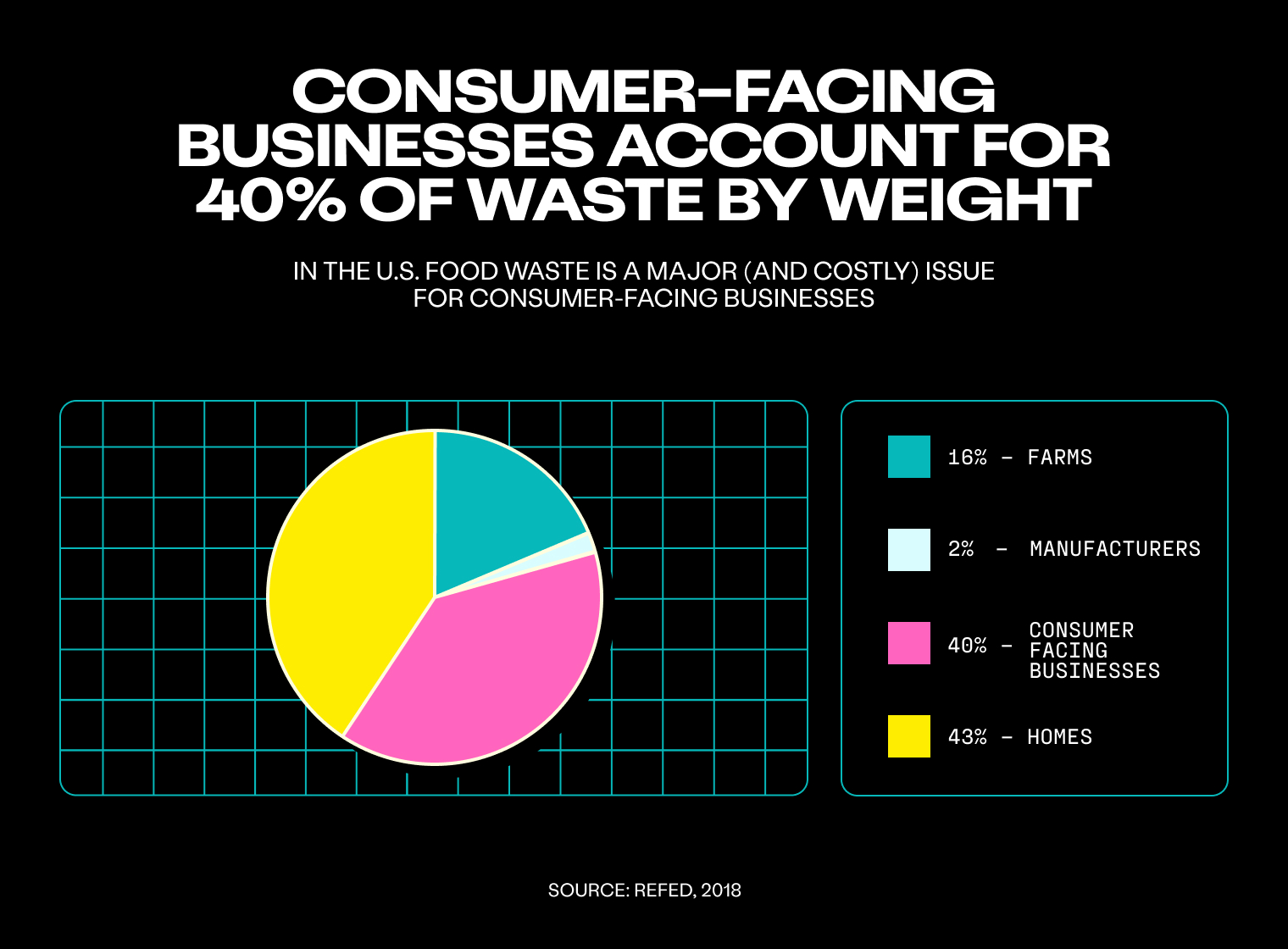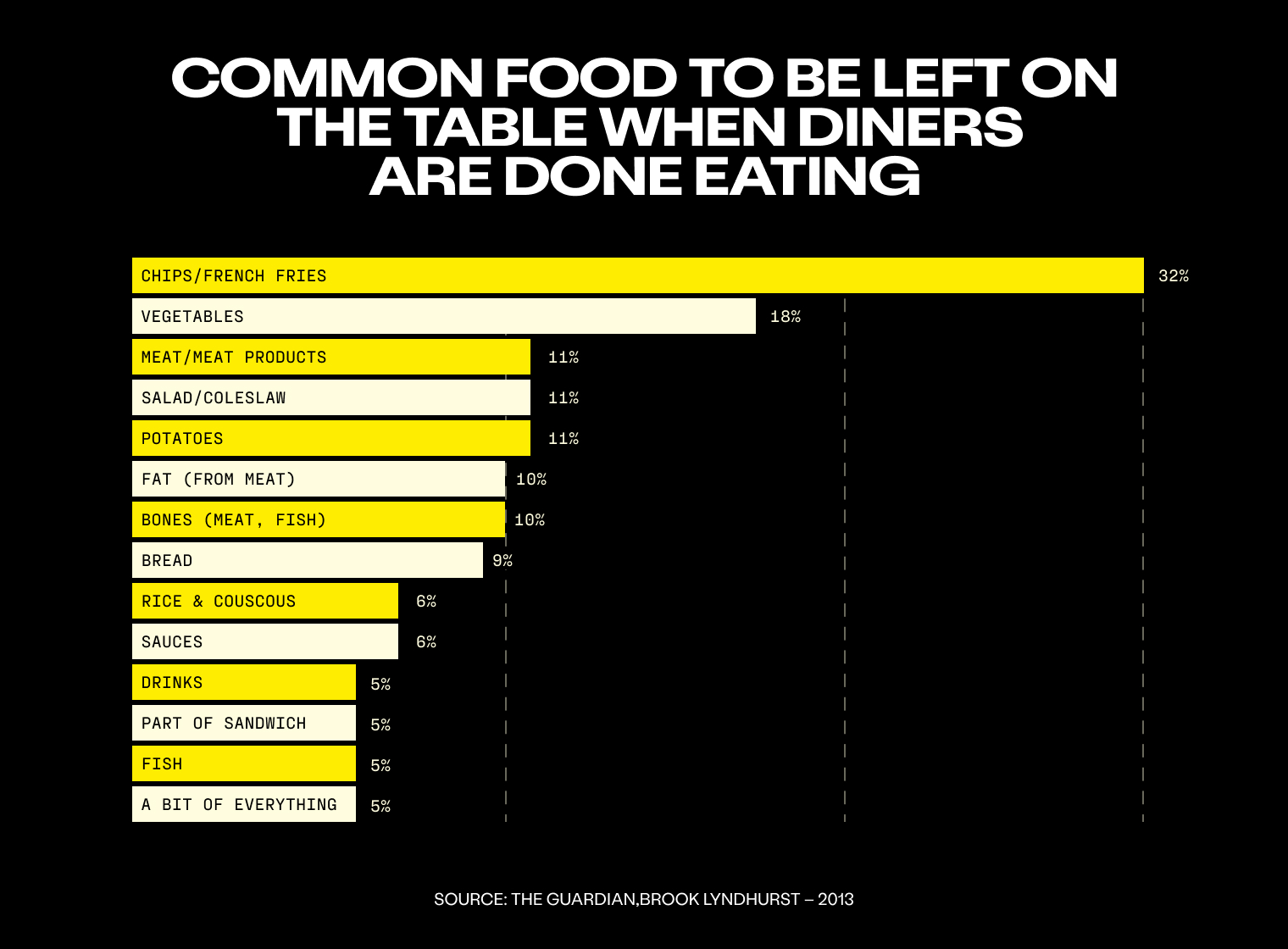Labeling is key: once items are opened, the date of opening or best by date should be written on it. Housemade items like dressings and sauces should also have a date that it was made affixed to them.
Share
- Jump to:
A half-eaten plate of french fries. A wilted bag of romaine. Moldy lemons. Floppy carrots. Chicken breast that was left out for too long. An entree that was entered in your POS system incorrectly. Bread crusts. A customer forgot to disclose that they couldn’t consume dairy, and now a barely touched pasta dish sits left on their table.
These are just a few examples of what restaurant food waste looks like.
In the U.S., restaurants waste between 22 to 33 billion pounds of food waste each year. Food takes up the most space in landfills, and when food waste ends up here (instead of being composted) it releases large amounts of greenhouse gasses into the atmosphere.

In the U.S.Food waste is a major (and costly) issue for consumer-facing businesses. Source: ReFed, 2018
Food waste is not only bad for the environment, but it also negatively impacts your restaurant’s profit margins. Every year, the restaurant industry loses a shocking amount to food waste: $162 billion.
For the most part, food waste in restaurants stems from overbuying, overproduction, and spoilage.
As a restaurant or foodservice operation, you have an opportunity to greatly reduce food waste, and as a result, reduce your environmental impact, save money, increase profits, and show environmentally-conscious customers that you care.
Where is the Food Waste Coming From?
When it comes to food waste in restaurants and food waste in general, there are some truly astounding statistics. The restaurants and food service industry actually plays a huge role in this global issue; this industry produces about two to four times the waste of retailers, grocery stores, and wholesale distributors combined. How did food waste become the crisis it is today?
Food is wasted at multiple points in a food service operation. Inventory may arrive as unusable, or management may have ordered too much of one or more ingredients. Food sitting in your fridges or pantries may not be stored properly and go bad. Orders might be entered and made incorrectly.
Guests may not be able to finish large portion sizes (this is thought to be one of the top causes of food waste in restaurants). Additionally, when eating out, customers have the “not at home” mentality. It is easier for mindfulness and sustainability practices to go out the window when diners are not in their regular environment. They may choose to order more than they can eat, and leave perfectly good leftover food at the table.
Why Do Restaurants Throw Away Food?
The last thing a restaurant wants to do is make its customers sick, so most will follow the “When in doubt, throw it out” rule. While restaurants should certainly throw out food that is moldy or unsafe, food going bad is something that can absolutely be prevented.
At the end of the day, there is often pre-made food and meals leftover that were not sold. Sure employers can take some home, and some can be given away, but more often than not, the food is just trashed. Some restaurants have strict rules on giving away food for free, while others do not currently have the infrastructure to donate or compost it.
Tips on Reducing Waste
It may feel overwhelming to tackle food waste reduction since it's such a problem in the restaurant industry, but no need to fret; it’s not rocket science.

Reducing food waste at the source is the most ideal option while letting food waste go to the landfill is the least preferred. Source: California Department of Food and Agriculture, 2022
Food can get wasted at many different points within a restaurant business, so it is crucial to take a multipronged approach to this issue. The U.S. Environmental Protection Agency (EPA) Food Recovery Hierarchy (shown above) highlights actions businesses can take to prevent and divert wasted food. As you see, prevention is the most preferred option. Restaurants should start with a waste audit to see where most food loss occurs within their restaurant.
Once you figure out how to manage your food waste, your customers will love you for it. A study by Unilever found that in the U.S., 72 percent of diners care about food waste management in restaurants, and 47 percent would be happy to spend more at restaurants that have some type of food waste program.
Without further ado, here are a few ways your restaurant can begin to manage food waste:
1. Upgrade Ordering Systems with Latest Technology.
Restaurant technology increases the efficiency and success of your business, as well as reduces the amount of food waste that happens behind your doors. First off, an inventory system (many POS systems include this feature) will ensure your kitchen only orders what is actually needed, and your BOH (back-of-house) staff is well aware of what is in stock at all times (doing inventory by hand is not always so accurate!). Being able to access historical ordering patterns through ordering systems will help you predict the amount of food needed.
2. Teach your employees.
Your employees will have the most effect on how much food is wasted in your restaurant since they are the ones that are directly handling food on a daily basis. Owners, operators, and managers may be the ones who order the food, but they must also be the ones that set forth the standards on how the food is stored, managed, and used. Employees can be taught how to get the most out of a cut of meat, how to utilize leftovers, techniques to keep foods fresh longer and to use the oldest food first. Additionally, it is good practice for your employees to ask customers if they have any food allergies, and repeat the order back to the table to ensure it is correct.
3. Consider food storage.
Food storage is incredibly important for increasing shelf life. Not all of your ingredients will be stored in the same manner of course, so consider what the optimal storage is for the individual item. Take note that fruits and vegetables get wasted the most (45 percent of all that is produced goes to waste). For other foods, 35 percent of seafood, 30 percent of cereals, and 20 percent of meat and dairy products that are produced are wasted by consumers, suppliers, and retailers each year. Refrigerators and freezers should be monitored with digital sensors to ensure that they maintain safe temperatures.
4. Optimize supply chains.
When food is transported hundreds to thousands of miles, the chances of it going bad during transit or shortly after is high. If you coordinate an efficient supply chain, this will get products to the restaurant quicker and reduce the risk of food loss along the way, and this can be done using software solutions.
5. Feed people in need.
With so many people experiencing food insecurity in America, it is illogical that so much food is thrown out. One-third of all food produced goes to waste in America when it could be going to a person in need. As a busy restaurant, you should ideally find an organization that offers flexible pick-up times and transportation.
For example, Lunchbox is officially Rethink Certified, a partnership that invites all our restaurant clients to incorporate philanthropic support into their operations to help provide nutritious meals for local communities impacted by food insecurity.
6. Compost or recycle.
Food loss turns into the trash, and restaurants typically produce 100,000 pounds of trash every year. One option is composting organic waste like food, paper towels, napkins, and biodegradable utensils. When restaurant chooses to both compost and recycle, they can
cut their waste by nearly 90 percent. Certain cities in the U.S. offer composting facilities and programs for restaurants, where organic waste is turned into fertilizer. Or, methane is harvested from rotting waste and then burned to generate power.

French fries and chips are often served in large portions on the table, and this is the most common food to be left on the table when diners are done eating. Source: The Guardian, Brook Lyndhurst, 2013
7. Consider portion sizes.
Many restaurants offer unnecessarily large portions that their customers never finish. In fact, many restaurants' meals are actually seven to eight times larger than what the FDA recommends for serving sizes. One idea is to offer different portion sizes on your menus, such as a “half” or “full” salad. A la carte items, appetizers, and tapas are a few menu items that can be provided for customers looking to eat a light meal. Waiters can ask customers how hungry they are to determine how much food should be ordered for the table. Your menu can also list an estimate for how many a particular dish would serve.
Do your dishes come with garnishes that customers never eat? Consider finding creative and beautiful ways to plate dishes without garnishes that always go straight to the dumpster. Plate appropriately portioned menu items on smaller dishes to make customers still feel like they have a very full plate (which they are accustomed to seeing at most restaurants) despite the fact that they have less food.

Reducing food waste can be an art. Here is an example of what using food scraps could look like. Source: John Hopkins Center for a Livable Future, 2015
8. Incorporate scraps and peels.
One form of food rescue is to repurpose what would normally be considered unusable. Chefs can use vegetable scraps for soup stocks, while vegetable pulp and leftover grains can be transformed into burger patties. Lard is perfect for cooking rich dishes, while bones can be boiled down for a deeply flavorful broth. Odd ends like kale stems can be pickled for a unique garnish. Kitchens always have leftover bits and pieces of food; instead of going straight to the trash, your BOH staff can transform these food scraps and peels into specialty dishes that customers wouldn’t find on a regular menu (and draw in the customers that care about sustainability!).
9. Partner with food waste-focused companies.
Some food banks or soup kitchens may not be able to accept every donation, and there may be last-minute items like hot meals or salads that won’t stay fresh for long. In these situations, restaurants can partner with certain organizations that accept menu items like this. One example is Too Good To Go, which is a company based in the U.S. and Europe that allows stores and restaurants to sell surplus food at a discounted price to customers that use its app.
Conclusion
Climate change is impossible to ignore at this point, and diners across the world are demanding more sustainability and accountability. For good reason too; the restaurant and foodservice industry is responsible for an astronomical amount of food waste. As a restaurant owner, operator, or manager, you have an opportunity to make a huge impact on food waste reduction. On top of saving money and increasing profits, your restaurant can minimize greenhouse gas emissions, feed the food insecure, and provide a useful second life for food scraps previously considered unusable.